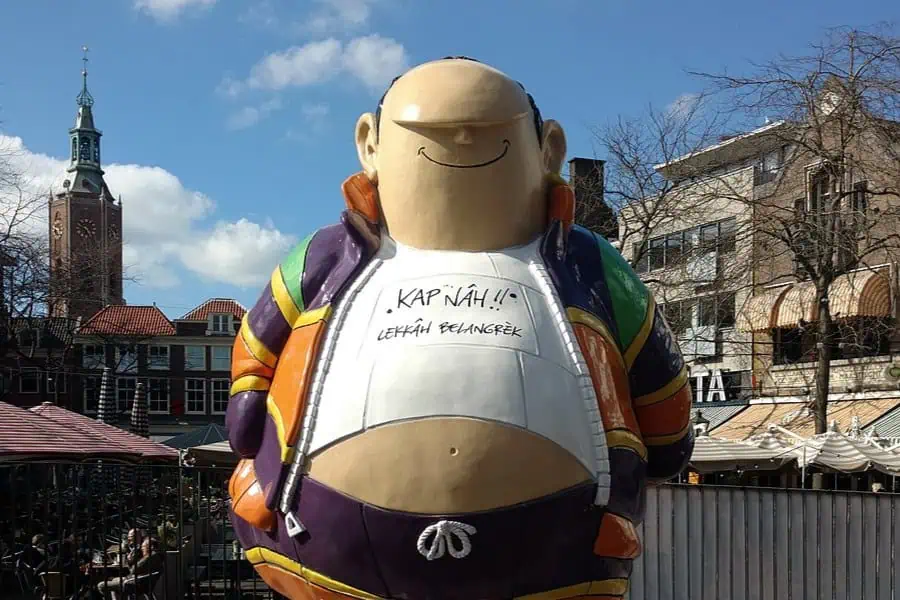It’s a typical night out in The Hague: you meet up with your friends at Grote Markt, you pick a terrasje, sit down for a couple (dozen) biertjes, and when you’re ready to dance it out or go home, you pass by Harry to pay your respects — wait, who?
It’s Haagse Harry, natuurlijk!
You know, “Harry from The Hague”, the guy from the big, colourful statue towering over Grote Markt — you can hardly miss him.
But who is he, and what did he do to deserve a statue?
Let’s delve into the story behind the most famous Hagenees to (n)ever live. 👇
Who is Haagse Harry?
Helaas, Haagse Harry doesn’t exist. He is a fictional character from a comic strip, and he’s meant to represent a stereotypical Agga dweller.
READ MORE | Dutch quirk #8: Dress the same as every other Dutchie (aka the Dutch uniform)
As a result, his typical traits include a big belly, a mullet, an outfit that consists of an evergreen tracksuit and white sneakers, and a very short temper.

He is also unemployed unless we count religiously watching ADO Den Haag football games and walking around cursing everyone as a job. In this case, he’s very busy.
Who invented Haagse Harry?
The brilliant mind behind this character is Dutch illustrator and comic artist Marnix Rueb.
After living in Schilderswijk for a few years, in 1991, Rueb distilled his impressions of all the special characters he encountered in The Hague into Haagse Harry.
Harry became the protagonist of Rueb’s short comic insert in the nightlife newspaper “Doen”.
READ NEXT | 7 things you didn’t know about The Hague
Far from getting offended, the people of The Hague found Harry so funny that they would rush to get the paper, tear out the comic strip, and throw away the rest.
After three years, it was clear that Harry needed to move into a bigger place: what started as a short insert became a stand-alone comic series that went on to have five albums.
What happens in these comics?
Haagse Harry’s stories are mainly about him hanging around the Hague, endlessly complaining about the state of things or quarrelling with people.
His favourite verbal match opponent is his wife, the equally iconic Haagse Bianca.
What makes Harry and the other characters in the series stand out, however, is not just what they say but how they say it: they all talk in the unmistakable The Hague dialect.

In fact, one of Harry’s typical phrases can be found on his statue’s shirt: “Kap nâh!! Lekkâh belangrèk.”
Wait, what language is that?!
Yeah… you won’t find this one on Duolingo. 🤔
Believe it or not, Harry does speak Dutch — his words are just spelt according to The Hague pronunciation.
In standard Dutch, the sentence reads as “kap nou!! Lekker belangrijk”, roughly translating to “Stop it! Very important” — and it’s meant sarcastically.
Rueb, however, had the genius idea to write the entire series with a special spelling system he invented to convey The Hague’s flat accent.
Of course, this means that the comic is not very beginner-friendly for those of us trying to learn Dutch — but it also makes for a truly immersive experience into raw Dutch culture.
Why is there a huge statue of Haagse Harry in The Hague?
When Marnix Rueb passed away in 2014, the city of The Hague mourned his loss, as well as the end of the Haagse Harry series.
As a result, in 2015, the city posthumously awarded Rueb The Hague Culture Award and commissioned a statue of Haagse Harry in his honour.
READ NEXT | 5 weird statues in the Netherlands
In 2016, the 2-metre tall, 3-tonnes heavy rendition of Harry we’ve come to know and love was unveiled, instantly becoming an iconic The Hague landmark.
The statue’s Grote Markt location is perfect, making both a great meeting point for locals and a fun selfie spot for tourists, who can capture the elegant Grote Kerk Tower and down-to-earth Harry in one shot.
And, bonus point, it’s also an amazing people-watching location — something that both Harry and Marnix would likely appreciate.
In fact, it’s easy to picture them together on the benches near the statue, bickering and making fun of the people passing by. 🥰
What’s your favourite Dutch city landmark? Don’t be a gatekeeper — share your go-to spots in the comments below.




